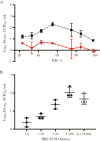Influenza Virus Infectivity Is Retained in Aerosols and Droplets Independent of Relative Humidity
- PMID: 29878137
- PMCID: PMC6057527
- DOI: 10.1093/infdis/jiy221
Influenza Virus Infectivity Is Retained in Aerosols and Droplets Independent of Relative Humidity
Abstract
Pandemic and seasonal influenza viruses can be transmitted through aerosols and droplets, in which viruses must remain stable and infectious across a wide range of environmental conditions. Using humidity-controlled chambers, we studied the impact of relative humidity on the stability of 2009 pandemic influenza A(H1N1) virus in suspended aerosols and stationary droplets. Contrary to the prevailing paradigm that humidity modulates the stability of respiratory viruses in aerosols, we found that viruses supplemented with material from the apical surface of differentiated primary human airway epithelial cells remained equally infectious for 1 hour at all relative humidities tested. This sustained infectivity was observed in both fine aerosols and stationary droplets. Our data suggest, for the first time, that influenza viruses remain highly stable and infectious in aerosols across a wide range of relative humidities. These results have significant implications for understanding the mechanisms of transmission of influenza and its seasonality.
Figures





References
-
- Lakdawala SS, Subbarao K. The ongoing battle against influenza: The challenge of flu transmission. Nat Med 2012; 18:1468–70. - PubMed
Publication types
MeSH terms
Substances
Grants and funding
LinkOut - more resources
Full Text Sources
Other Literature Sources

